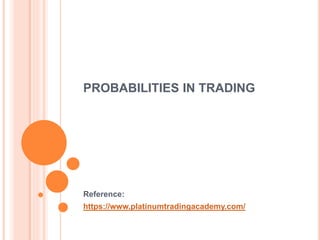
Probabilities in trading
- 2. INDEX 1. Probabilities In Trading 2. Think In Probabilities 3. Premium Service Subscribers
- 4. PROBABILITIES IN TRADING I was speaking over the telephone a few days ago with one or two subscribers to the PREMIUM SERVICE. I noticed a consistency, as they were relatively new traders to Forex.
- 5. The consistency was that they spoke as if they knew what the markets were going to do next. In reality, experienced traders would usually speak in probabilities and typically have some form of analysis to back up their opinion.
- 6. No one can say that a particular currency pair will move to an exact point with absolute certainty. In fact, I feel it is naïve to think that anyone can predict the direction of a currency pair with absolute certainty over a given period of time. Sure, sometimes you could be correct if you boldly predict that a pair will move to X level with absolute certainty.
- 7. However, there will be other times when the market doesn’t go your way. That is why we must deal with probabilities, because no one knows for sure what will happen next in a given currency pair.
- 8. The reason we can never know where a currency pair is going with absolute certainty is that the markets move based on the will of every market participant. Let’s suppose that someone stated “the EUR/USD will definitely rise to point X, before falling down to point Y”.
- 9. They are saying that they know exactly what every trader is thinking, how each of these traders plan to act, and how each trader will respond to the actions of every other trader. Needless to say, no one could ever have that information.
- 10. However, it isn’t uncommon to see bold predictions that definitely state which direction a currency pair will go and exactly where the move will begin and end. No one can know these types of moves for certain. Even worse, it isn’t hard to find predictions that say something like “buy the USD/JPY at X or you will regret it”.
- 11. This baseless claim gives virtually no useful information because we don’t have any idea how long of a trade this would be or where the exits (stop and limit(s)) are. Without being too harsh, just beware of anyone who claims they know for certain where a currency pair is headed. Of course everyone can be entitled to his or her opinion, but that doesn’t mean they “know” what will happen next.
- 12. THINK IN PROBABILITIES Therefore, we must think in probabilities. No matter how good / sensational your analysis is, sometimes you will simply be on the wrong side of the market. Whether you are looking at fundamental news announcements, a combination of technical tools, or a simple moving average, as traders what we are looking for are patterns that put the probabilities in our favour so that we will profit in the long run.
- 13. In other words, we are looking for how the market has reacted in the past to certain conditions, and speculating how likely the market will react in the future to similar conditions.
- 14. Regardless of the tools you use to analyise the market, you are still working with probabilities. If you find a system that is profitable over a long period of time, that system is likely putting the probabilities on your side. These systems come in a variety of shapes and sizes.
- 15. Every trader has their own system; one of my trading buddies is hooked on an easy mathematical calculation system makes no sense to me but he says it works for him. I think I have his system correct below.
- 16. He uses only SMA’s and Bollinger bands plus pressure charts to show both momentum and trends. Exactly how he determines an entry or exit I am not 100% certain: - 1. The system requires 40% of trades to reach the profit target in order to break even. 2. The reason for 40% is that he works on a risk/reward ratio of 1:1.5.
- 17. 3. Therefore, if he has only a 50% success rate on profitable trades, he would be very profitable over time. 4. Even having 45% of all trades being profitable is a success and provides a great return. 5. In fact, anything above a 50% profitable trade rate is fantastic.
- 18. 6. Therefore, it is plain to see that it is not necessary to know where the market will go on each individual trade. Instead, it is important to have a system that that places increased probabilities in your favour over a large sample size of trades.
- 19. At the end of the day, it’s is all about RISK and MONEY MANAGEMENT, as traders we are RISK ASSESSORS…we PLAN OUR TRADES and TRADE OUR TRADING PLANS. No matter what system you adapt to for trading, as long as you have good discipline, you stand a better than average chance of survival as a trader. Without discipline you are doomed over time.
- 20. PREMIUM SERVICE SUBSCRIBERS Many of the PREMIUM SERVICE subscribers have asked me, what do I use to plan a trade. 1. Discipline. 2. Fibonacci levels 3. Pivot points 4. 100 and 200 day SMA’s 5. Sometimes….Bollinger bands (I hate my charts to look too busy).
- 21. As long as you can use and relate to the probabilities in trading in your favour and that they work over an extended longer period of time, the individual results on each individual trade are almost meaningless. Like all traders I take losses.
- 22. The key is to manage those losses correctly so that the long-term track record remains profitable. The bottom line is that thinking of trading in terms of probabilities is a key step to becoming a successful trader.
- 23. THANK YOU
